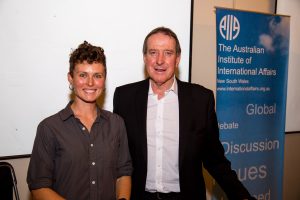Banning Nuclear Weapons
At Glover Cottages on 28 March we marked the opening of negotiations at the United Nations General Assembly in New York to ban nuclear weapons. Our speakers were Gem Romuld of the International Campaign to Abolish Nuclear Weapons (ICAN), and Robert Tickner, former under-secretary for the International Red Cross and Red Crescent Federation.
Robert noted progression towards outlawing nuclear weapons. As a federal minister under Bob Hawke and Paul Keating, he had been involved with Gareth Evans in establishing a South Pacific nuclear Free Zone in 1985. In 2011, the International Court of Justice made the use of such weapons illegal. But making their actual presence illegal is a new push, bitterly opposed by the nuclear haves, but widely applauded by almost all nuclear have-not states except those, like Australia, which misguidedly or otherwise rely on the United States nuclear umbrella for protection.
Momentum for such a ban has been building through conferences supported by the International Red Cross and other NGOs in Norway, Mexico, Vienna and elsewhere. A sense of urgency has recently been stimulated by several factors: the failure of the haves to honour their undertaking under Article Six of the NPT to abolish their nuclear arsenals; a push by the nuclear weapons states, especially the United States and Russia, to improve the explosive power of their bombs and the accuracy of their missiles while claiming disingenuously to be reducing their arsenals; the emergence of North Korea as the newest (ninth) nuclear power; and the erratic and blustering pre-election pronouncements of Donald Trump about nuclear weapons, their potential use in warfare, and how he might allow both Japan and South Korea to develop their own.
Gem Romuld noted that the negotiations in New York would proceed through two sessions, the second one in June. Optimistically, a treaty to ban nuclear weapons might be drafted and in place for signature by July 2017. The intention of its proponents was that it would not need a certain number of signatories before coming into effect, but would do so immediately. And it would not be time-bound, but would apply indefinitely.

What about Australia? Both Gem and Robert explained that Australia would not be present in New York. The US leaned heavily on Canberra not to participate, as it did on all other allies depending on its nuclear umbrella, and the Turnbull government agreed not to do so. This is an undemocratic position given that a majority of Australians would favour a treaty banning the existence of nuclear weapons. But, as Gem recalled, democracy has never had anything to do with Australian positions on nuclear weapons. In British nuclear experiments, twelve nuclear devices were detonated on Australian soil and contaminated thousands of square kilometres of desert with transuranic elements, including plutonium Pu 239, (which has a half-life of 24,400 years). Successive Australian governments on both sides of the politics were guilty of ignorance, incompetence and cynicism.
Both speakers believed that the existence of an international treaty outlawing the existence of nuclear weapons and their delivery may have no initial effect on the nuclear weapons states. But by adding one more treaty to the bans on weapons of mass destruction, like chemical and biological weapons, cluster bombs and landmines, its presence and wide support among a majority of the international community may indeed have a long term moral effect.
Richard Broinowski